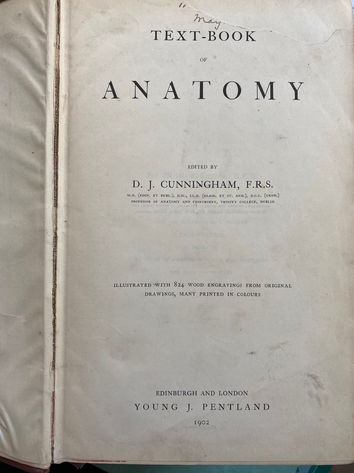Daniel John Cunningham
(1850-1909)
Daniel John Cunningham was an important figure as the Professor of Anatomy at Trinity College Dublin during the 19th century. Cunningham was born in Scotland leading him to study medicine at Edinburgh University. Eventually, he left Edinburgh and moved to Dublin where he was a professor of anatomy at RCSI. He held this position for one year until he got the position at TCD, working there for the next 20 years.
Anatomists discovered that in order to expand their research goals and findings, it is important to create models of the brain. Some anatomists would examine the brain under a microscope and draw the specimens. Eventually this turned to ceroplasty, the art of wax sculpture. French surgeon Guillaume Desnoues and artist Francois de La Croix created wax models of the brain, allowing anatomists to better understand structures of the brain and to share the models in medical education. These wax models were gifted to Trinity College Dublin in the 18th century, however many anatomists found that Desnoues’ collection was outdated by the 19th century. Fortunately, Cunningham fostered a new approach to observing the brain.

In his time at Trinity College, Cunningham displayed a passionate interest in neurology and neuroanatomy. He delivered several publications with a strong dedication to the study of the topographical anatomy of the brain. Cunningham developed a creative tool to showcase his knowledge to his students by preserving brain dissections in plaster. These dissected brain samples showcased various structures such as the Circle of Willis, cranial nerves, cerebral regions, and the thalamus.
Furthermore, Cunningham recognised that photography could be useful in his teachings, so he produced the “Stereoscopic Studies of Anatomy” manual. This manual allowed students to view stereoscopic plates that displayed a brain specimen. The specimens were photographed in different angles, and when put up to a stereoscope viewing apparatus, the specimens would be displayed in a three-dimensional effect. This made Cunningham the first to employ spectroscopy in medical education, influencing other educators in a broader range of disciplines such as surgery and dermatology.
Cunningham was a key figure in expanding the technology used for medical training as dissections and anatomical models were commonly used in lessons for anatomy. His work is displayed in the Old Anatomy Museum at Trinity. Cunningham’s methods of teaching contributed to the medical education that developed in Trinity College, also contributing to the field of neurology.
Wet specimens prepared by D. J. Cunningham (initials inscribed) showing human cerebral anatomy.
Sources
Brain – anatomy.edwardworthlibrary.ie ©. (n.d.). https://anatomy.edwardworthlibrary.ie/the-human-body/nervous-system/brain/
Cunningham, Daniel John | Dictionary of Irish Biography. (n.d.). https://www.dib.ie/biography/cunningham-daniel-john-a2300
Dublin – anatomy.edwardworthlibrary.ie ©. (n.d.). https://anatomy.edwardworthlibrary.ie/teaching-anatomy/dublin/












